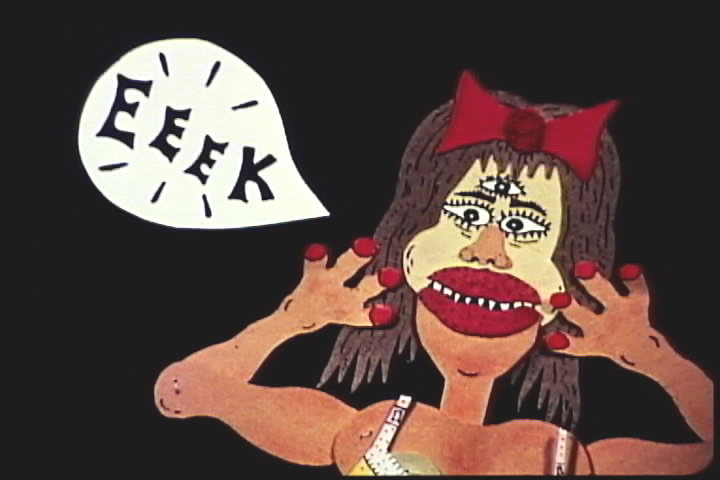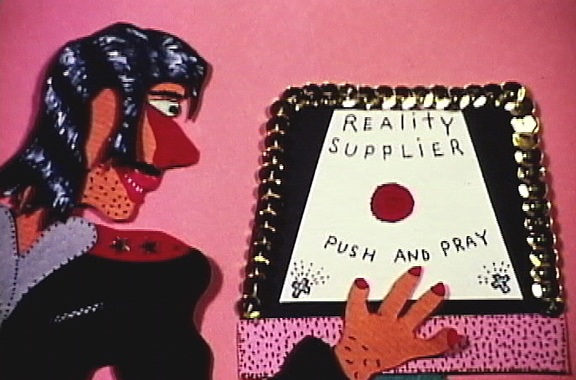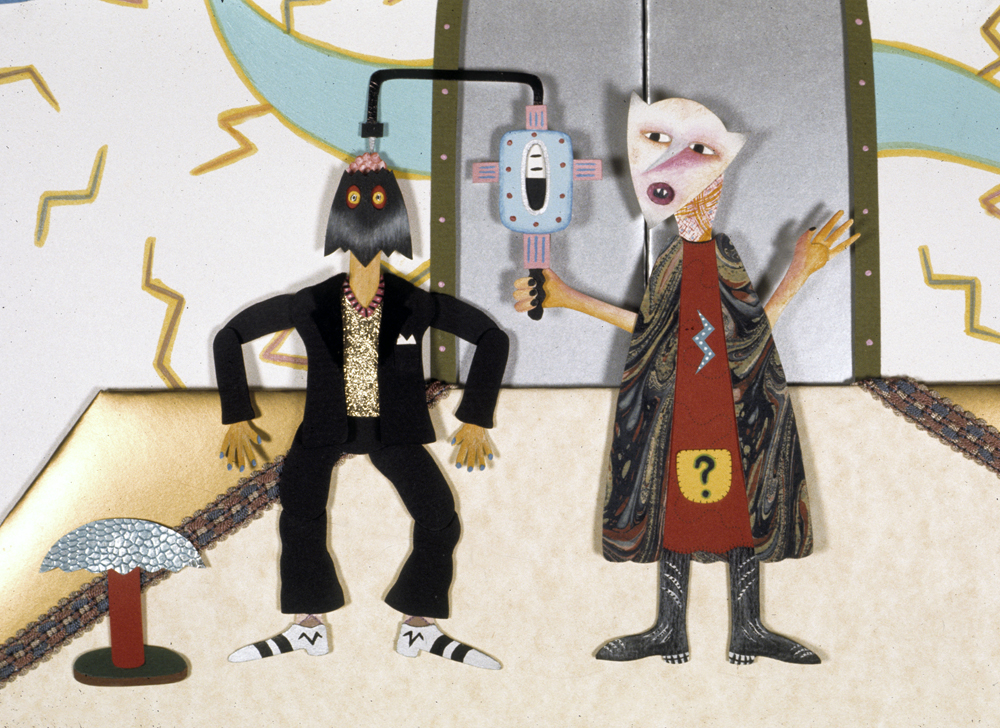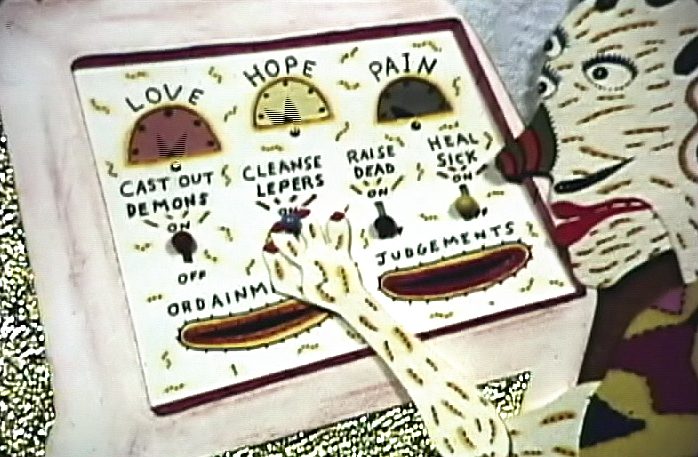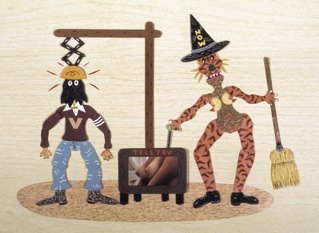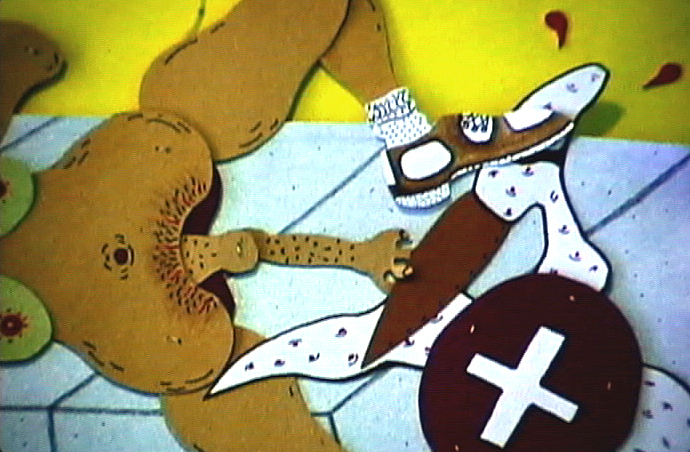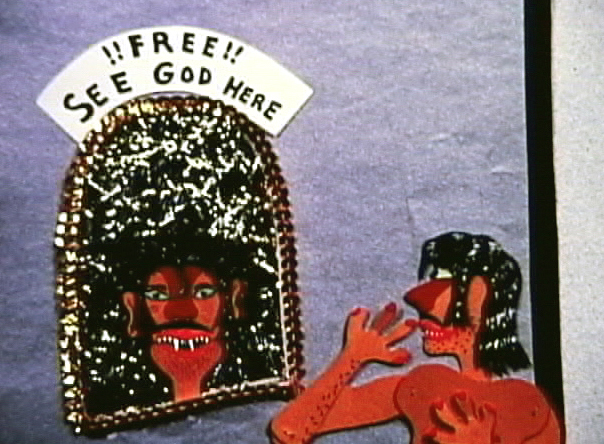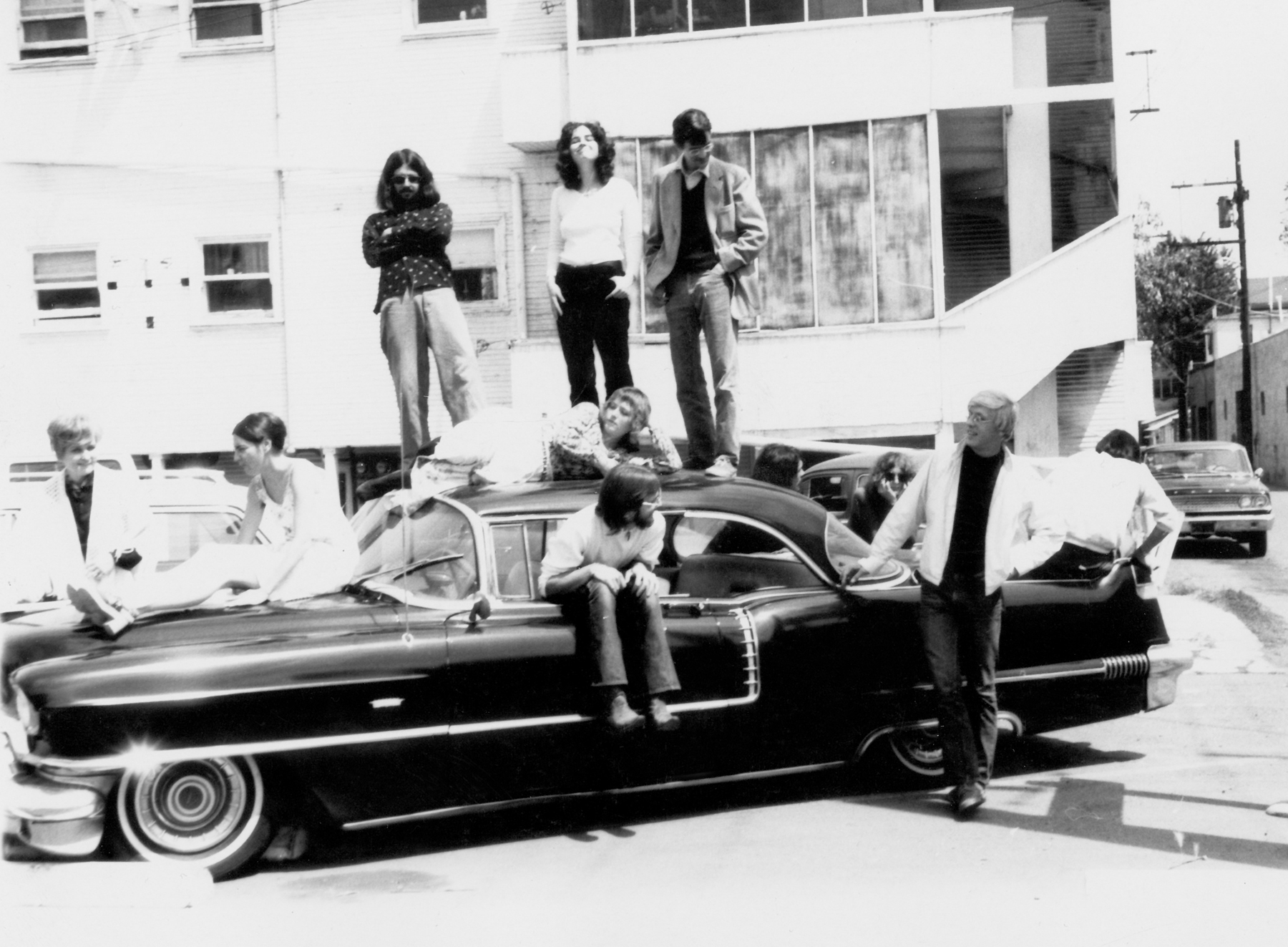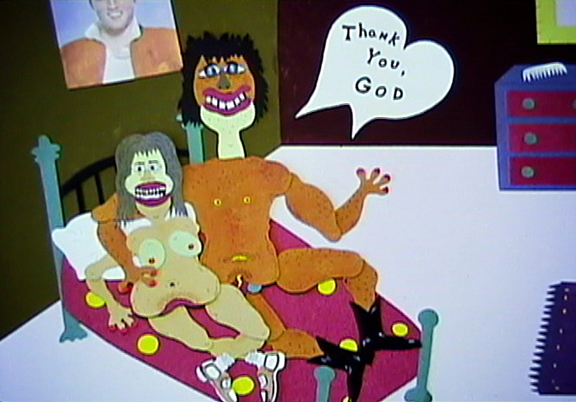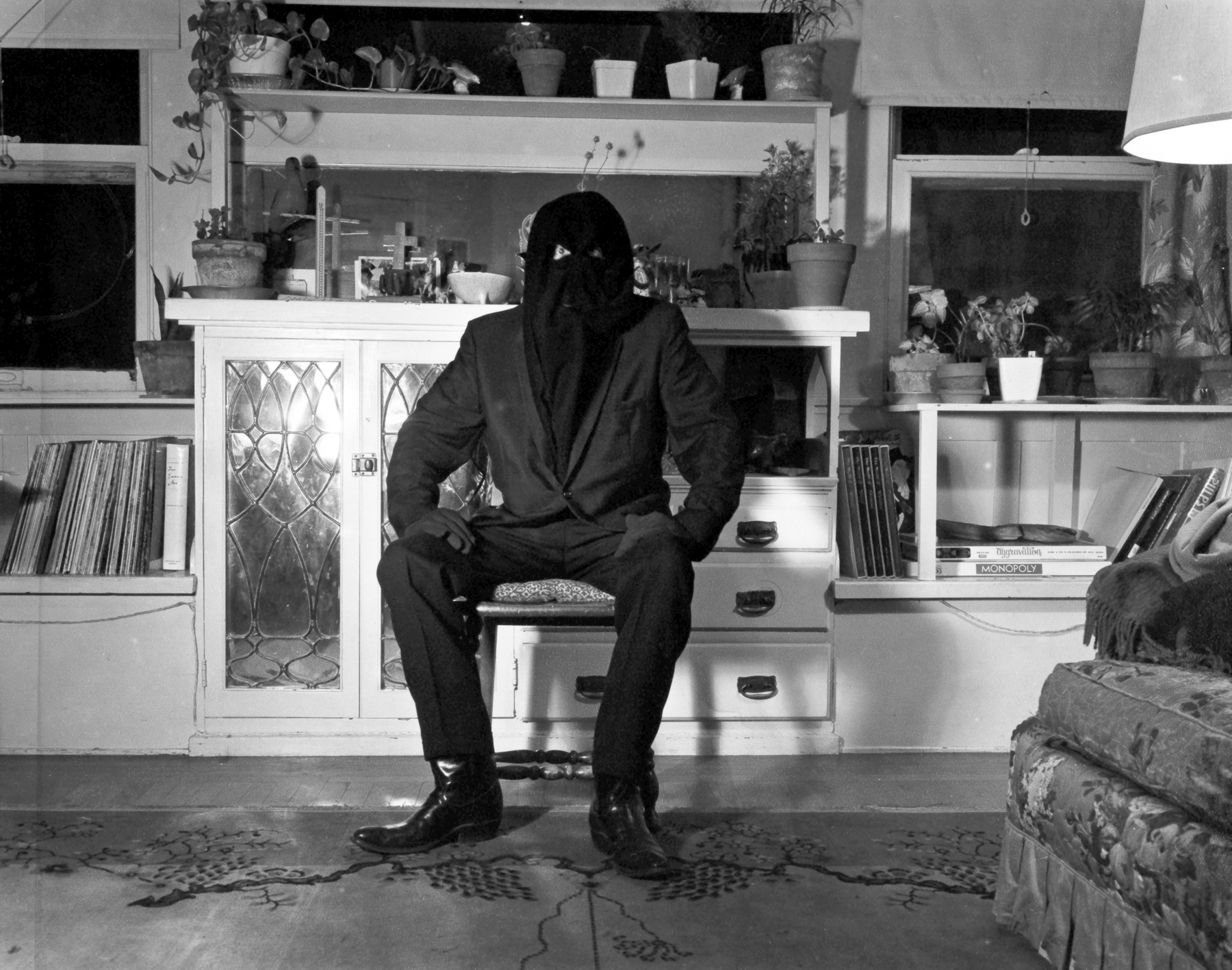This excerpt is Part 1 of a three-part article on the career of visual artist and filmmaker Victor Faccinto.
I was not prepared for my first Faccinto film, which I saw in 2009 at a screening held by Pittsburgh’s dedicated experimental film collective, Jefferson Presents. Among the selection of avant-garde classics on bill that night was an animated-short about a character named Video Vic, an unassuming everyman who embarks upon an existential, inter-galactic journey to save his girlfriend, Rita, from the clutches of evil. The film not only had a promising title, SHAMELESS, but also included a disclaimer that read: “not recommended for gentle sensibilities”. Despite the fair warning, my not-so-gentle sensibilities were irrevocably shaken by the salacious exploits of an animated paper doll. Innocent, sinister, silly, sad, sappy, sexy, psychedelic, horrifying, hilarious and vibrantly unforgettable, SHAMELESS burned a hole into my creative consciousness that still smolders to this day.
Influenced by television of the 1950’s, underground comics of the late 1960’s and the uninhibited cinema of the early 1970’s, Victor Faccinto’s early animated films are psychedelic passion plays meticulously crafted out of paint, paper, found objects, naked ladies and the occasional slab of raw meat. The “Video Vic Series” includes four 16mm titles: WHERE IS IT ALL GOING? WHERE DID IT ALL COME FROM? (1970), THE SECRETE OF LIFE (1971), FILET OF SOUL (1972) and SHAMELESS (1974), as well as two digital animations: NIGHTMARE (2009) and TO HELL AND BACK (2010). Each film follows Video Vic, a masked hero/villain who is perpetually tangled-up in the complicated web of his own desires, and plagued by the consequences of mortal sin. Reverently subversive and politely pornographic, the Video Vic films are astonishingly intricate creations of an artist intent on conquering new territories without using a map. I visited Victor in 2013 at his home in North Carolina, hoping to find out more about where it all came from, and where it’s all going. Below is an excerpt from our conversation.
__________________________________
Victor: I was a very late bloomer. I didn’t even start making art until I was almost 25. I went to undergraduate college for about six years and studied other things, but not art. I began taking studio art classes at Sacramento State in 1968.
Tara: What happened in ’68? Was there some sort of catalyst?
Yes, it was an acid trip in San Francisco, December 31, 1968, New Year’s Eve. I was in a flat somewhere in the Haight Ashbury area. I had gone to a party thrown by someone I went to High School with who was a “head”. You know what a “head” is, right? He had invited a few of his old friends from Sacramento, who were into smoking grass and taking acid, to his New Year’s Eve party. We drove down, went to his flat, sat down on the couch and dropped acid. Just after taking it, in walked about four or five Hells Angels. I don’t know why they were there or where they came from, they may have been party crashing for all I know. They also took some acid. They weren’t hostile or anything like that, they just sat right down next to us and kind of played with our brains. Maybe they were trying to see if we would get paranoid or scared or something like that. Again, they didn’t appear threatening – they were just powerful, overwhelming images. However, once the acid took hold, they became very evil looking: gruffy old guys with beards, wearing those Levi jackets with all the patches and stuff. Then they did begin to get a little pushy. After being there for what began to feel like much too long – the trip definitely wasn’t going in a positive direction – I went outside with a friend and we began walking down one of those hilly streets in San Francisco. We walked in the middle of the street, it was real late, after midnight, so there weren’t any cars to speak of and that’s when I first saw the devils in the street in front of us. I now suspect that they were streetlight reflections from which my mind formed an image, but at the time they were living entities. Like the Hells Angels, they weren’t threatening, but they were very peculiar, and they looked very real. At that point in time both of us started having a bad trip. You know, when you get real paranoid and you are not sure if you are ever going to be able to get back to where you were when you started. So that feeling, on top of seeing the devils, was so intense the only thing that I wanted was to return to real life again. Whatever that is.
Can you describe what the devils looked like?
Fluid, with sharp-edged flame-like things on their arms and legs. They weren’t red, they were yellow and green and blue. They were gas-like, dancing in the street.
Did they have faces?
Yes, but not with rigid details. Always in motion, everything was in motion, you know? Like the apartment that I left, it looked like the walls were breathing and melting. When you are on acid, it can be like seeing the atoms that make up everything, and they are always moving. The more I think about it, that is what the devils were really –distorted light and reflections that formed into an image. But they didn’t speak; there wasn’t a confrontation or anything like that. All of the devils I have ever experienced have been visually perceived from a distance, appearing as part of the environment I was in at that moment. So I believed these things existed, and I accepted them as being real.
The intensity of that trip left a residue, and the residue was a mental imprint of those devils. It didn’t torture me, and it wasn’t like a lingering problem…but they were stuffed inside me somewhere, and they became big part of the visual subject matter I carried forward since that night.
The very next day, after I got back from San Francisco, I set up my 8mm camera that had a single frame function and I started spilling out this new emotional and visual residue into my first animated cartoon.
What was that film called?
I don’t know, but it was definitely primitive. I recently found it – and boy was it raw. It did have a title but I don’t remember what. Basically, the Devil showed up, God showed up, and it all started. All the Video Vic animated films were close to the same story, but they became more mature and more resolved and the paper characters and background sets became more refined as time passed. SHAMELESS was the final film of that period. I believed I had taken the technique and storyline as far as I could at the time. And that is a reoccurring theme to my history – I get to a point where I can’t make a better film, or painting or performance, I can only make one just as good. I reach the end of a line of work, and then it is time to shift to something else.
The sets and backgrounds in the Video Vic films are very detailed, and the characters elaborately articulated. How did your animation technique evolve after you made that first film?
After I got the first 8mm film back I realized I was on to something good and wanted to continue animating. I bought a 16mm Bolex in a pawn shop for $75. It was made in 1936 but was still in good working condition. Along with a used copy stand I was set up to go.
Each film proceeded in the same way. I first made the characters and background sets then just started the film. By the time I began the first film, I had already developed a somewhat primitive style of painting and drawing that included a God, Devil and an assortment of male and female figures that were easily adapted into cutout paper characters. Cutouts were the quickest way to animate, and animation brought them to life. Make a move, click off a few frames and make another move. I used 3 frames per movement in most cases, which worked well at 24fps. The motion was a little jerky at times, but jerky seemed to be appropriate for the images and storyline that might also be described as a bit jerky.
At first all the individual paper parts were laid on top of each other and I moved them separately. This caused a certain amount of chaos as the parts sometimes jumped around more than desired. I must credit my girlfriend at the time for a big step forward. Shelly had once been a member of a Brownie troop where she learned a method of making paper dolls that used thread to hinge the arms and legs to the doll bodies. I started using this technique and immediately had better control of the animated motion.
How were the soundtracks made?
The first two films were silent. I used cartoon caption bubbles for dialog and sound effects. “The Secrete of Life” was the first film with sound. I had finally managed to get enough control of the timing for post syncing the sound. I bought a 2 track Sony reel to reel tape deck and used a kazoo, sticks, slide flute, my mouth and a variety of other objects for the voices and sound effects. The soundtracks were recorded by me alone in an adjacent room while viewing a work print of the completed film through a window in a door.
Once Video Vic and Rita showed up in “Filet of Soul,” it became even more complicated as I was doing all the voices and sound effects in a single take. I wrote the dialog during the filming, making sure enough frames were available for the spoken words. It usually took me a week or more and around 20 practice takes to get an acceptable final version.
Very little editing was done to the original animated film rolls or soundtrack. They pretty much matched each other in their original versions. The film animation was created much like the sound, if I made a mistake during filming I did it over in the camera.
Your storylines are elaborate adventures following characters from world to world, where they confront demons, angels, monsters and fate-altering machines. How did you develop your stories?
The films were created in the same manner I made my paintings of that same period. I would start with a vague idea of the direction I intended to take. The characters were made first and their images suggested potential scenarios – It usually started with man, woman, god and the devil… hummm, sounds like the bible doesn’t it? The backgrounds were then created with open-ended purposes in mind – heaven, hell, bedroom, and countryside – for the action to take place. As the film progressed and specific details became clear, I would make or find the additional props I needed to complete a scene.
The stories pretty much told themselves; it was a lot like playing with toy soldiers. Once I began moving the characters around on the background sets, my imagination went to work and everything just came alive. One thing always led to another; developments in the daily news or in my personal life or a friend’s life suggested the stories, along with what admittedly was my unbridled, hormone-driven imagination at that time.
I recently found a statement I wrote about the films in 1972 where I noted that “the animator was like God, he had the exclusive power to create a world any way he wished.” In a sense this was my way to experience fantasized personal interactions that were not possible or acceptable in my real life – a place where the laws of physics did not apply; where everything was possible and I made all the decisions.
Many of your films feature God and the Devil, alternating between protagonist and antagonist. Particularly in the Video Vic series, Christian iconography is mixed with a vibrant and colorful aesthetic that references the fetishes found commonly in Mexican Catholicism. Why was Christianity so heavily referenced in these films? Were you raised Catholic? What role did Christianity play in your life?
Although my Father was Catholic, he died when I was very young and formal religion was not a big part of my childhood. That is except for several summers I spent with my Italian/Mexican relatives in Sanger, California. I attended Mass with them every Sunday and was taught the basics, including not going to see the Nun Story when the movie first came out. Just growing up in California went hand in hand with Mexican culture, and I was always attracted to their religious prints and plaster sculptures. Yes, the colors were intense and the subject matter provocative, especially the wall mountings of Jesus’ bloody crucifixion on the cross. All this spoke of death, violence, hell and almighty god all in the same breath. Visually it all made sense to me. One of the very first awards I received was an honorable mention in a Sacramento Religious Art Show competition in 1969. My piece was a much distorted crucifix painting, sort of like Jesus viewed on acid. I was genuinely surprised by this award. It taught me how thin the line could be between parody and the real thing.
Sexual violence is very prevalent in these films. With a few exceptions, the female characters are raped, stabbed, and mutilated, then “rescued” by a male character who starts the cycle over again. The male characters don’t have it easy either; many are castrated, tortured and otherwise punished for their evil deeds, only to be forgiven and given another chance to sin again.
Underground comics of the 60’s also featured sexual violence. Why do you think this was a prevalent theme in illustrated and animated work at that time?
As for the SF comics, they were just an extension of a tradition that always included a mix of sex, violence and humor. Just as the rest of society was testing limits, so did the comic artists, and to an extreme. I suspect they were influenced by the blatant pornography industry that thrived in San Francisco in the late 60s and early 70s, as well as the paranoia and distrust that replaced the optimism of the local Hippies.
Animation of that period was not all that focused on sexual violence. Most independent animators were making films with more positive themes. Why I chose to work as I did is not a question I can answer with any clarity. I really do not know. “Follow your instincts” was my theme. I was making films that seemed to reveal themselves as they grew. I do think that the introduction of Video Vic and Rita as characters in 1972 added a softer layer to the films. That was the beginning of my long term personal love relationship with Barbra, a fellow grad student, which was to last for the next 7 years. This real life passion carried over into the films. Video Vic was no longer just the behind the scenes creator; he, along with his girlfriend, was immersed in the action, and the films became a mix of love story and surreal adventures.
“Filet of Soul” added one other dimension – it was my response to what you referred to in your question as “male characters….punished for their evil deeds, only to be forgiven…” My actual experiences with what was then a relatively new “Feminists’ on the warpath” sensibility, led to the castration and redemption scene. The one with Video Vic and the NOW witch character that turned out to be Rita. From this point on, Video Vic does not personally take part in any sexual violence toward women. Of course the devil characters were still hard at work and it became Video Vic’s job rescue their victims, and his new behavior brought amble rewards from Rita.
Although sexual violence all but disappeared from my work after “Shameless” was completed in 1974, the Video Vic films have continued to follow me around ever since. Sort of like your bad kids you still love but no longer have any control over.
Do the films reflect what was going on in your personal life?
Well, yes and no. Although each female character was modeled after a girlfriend, the on screen violence was not directed at the real life person. Once they became paper dolls they functioned as actors, especially considering some of the torture they endured at the hands of the God/Devil….. not me.
Also many of the props and costumes were based on existing items worn or used by the girlfriend/models. For instance, Shelly was a senior at a Catholic High School when I met her. She wore the “real” uniform including a pair of brown and white oxfords. I used these shoes on the female lead character in the first two Video Vic films. I still think of her whenever I see the shoes.
In hindsight I believe I was just mirroring the spirit of the times. The daily news was full of horror story details of mass murders, serial killers, and hippies gone bad. I didn’t have to make that part up. There was also a sense of sexual freedom flourishing. Not much was taboo. All of this seemed to merge together. And of course “true love” was still around, it never goes away, and if you read deep enough you will find that all these early films are part love story, well maybe with the exception of “The Secrete of Life.” I still don’t know what to make of that one.
“The Secrete of Life” opens with an official-looking typewritten statement signed by Howard E. Garrett, PhD, which states a study had been done in the late 60’s to “investigate motivation and direction in human behavior”. It goes on to say that the “following account of one subjects’ progress will serve to illustrate the potential value of such research.”
Why add this caveat to the film?
It was just simple satire related to my experiences as a recent graduate in Psychology from Sacramento State. The department was focused on experimental psychology – you know rat experiments and all the formal documentation that goes with it. However, I did learned how to keep detailed records of experiments and that spilled over into my art making, proving to be a valuable tool for tracking details of my film animation and later video editing. This intro to “The Secrete of Life” was also my version of the introductions to many pseudo-social documentaries of the 30s. They would start with scrolling text or an official looking speaker who set the context for the film. Reefer Madness is a good example; in fact I used a section of the lecturing professor at the desk in “Book of Dead.” He was there to point out the evil in the film, then under this pretense anything could be shown, wasn’t his fault, nor was it Video Vic’s.
“The Secrete of Life” also makes a pointed reference to the pseudo-spirituality movements of the 60’s. Chico’s adventure starts with a message he receives that says “First Look Within”. He then goes to church. After many salacious adventures in Heaven/Hell, Chico becomes enlightened while hanging out on the cross, then gets bored and goes home to watch TV. How did you feel about the spiritual cults of the 1960’s and 70’s? Were you personally involved with any?
I practiced Transcendental Meditation for a short time in 1970. It worked but didn’t really mix well with all the other things I was doing. That may seem a vague answer, but I think it best I leave it at that. There certainly was no shortage of spiritual options available. Crumb’s Mr. Natural comes to mind about now. It seemed like someone was showing up with a new approach weekly. Usually some distorted version of Buddhism coupled with drugs. I remember one guy who claimed eating a specific flower seed from the state of Washington was the path to spiritual ecstasy. He looked a lot like Jesus and spent his time spreading the word wherever he went. Found out later he as an ex-convict. Anyway, at the time I made “The Secret of Life” I believed we were all a pile of atoms spinning in the universe – come what may – so why worry over it.
You are a native of Northern California. How did the culture of the area influence your work aesthetically and contextually?
Socially, 1966 – 1974 was probably one of the most experimental times in this country’s history, much of it centering in California. Almost every kind of behavior was considered acceptable, at least for a while. Even middle class adults were going to porno movies, smoking grass, and experimenting sexually. The San Francisco Underground Comics were at their peak popularity – mixing violence, sex and satire to an extreme. The Hippie culture rose and then fell – after Charles Manson and bad drugs stabbed it in the heart. This was all just daily news while I made the Video Vic films.
Were other filmmakers and artists supportive of your work?
I must admit I got a big boost when Robert Crumb came over to my apartment in downtown Sacramento and I showed him one of my films. His response was positive, but I have always suspected he was more interested in visiting his Sacramento girlfriend who lived a few doors away. And that would be justified based on his comic strips that always told the truth from his personal vantage point, as raw and coarse as that may be. Jim Nutt, the painter, was another artist with a personal uncensored psycho/sexual perspective who validated my early work and introduced me to the professional art world.
Where were your films shown during this period?
Much to the ire of some of the Graduate School faculty, Marcia Tucker, a curator from the Whitney Museum of Art, visited the art department in 1971 while I was still a graduate student and had me send “The Secrete of Life” to the museum’s film department. Soon afterward I was being shown in NYC. I also entered film festivals around the country and was accepted in almost everyone I entered. That was a surprise at the time, as these films were definitely X rated and would certainly not make the cut for today’s audience sensibilities, but that was the nature of the moment.
“Where is it all Going?, Where Did it all Come From?” won second prize at the 1st San Francisco Erotic Film Festival in 1970. I used the prize money to buy a black 1956 Cadillac. I couldn’t have been happier.
What kinds of reactions did you get from audiences?
Well, locally it was good. I guess I was considered one of the more successful and productive young local artists at the time. However not everyone could tolerate the Video Vic films’ mix of goofiness, sex and violence. I certainly did not blame them for that. I knew I wasn’t appealing to the masses. The local Women’s’ Liberation group did get “The Secrete of Life” removed from the University’s film collection. However there were enough positive reactions to let me know I wasn’t alone in the world.
Perhaps the most surprising audience reaction happened during a 1971 New Year’s Eve screening at a music concert in San Francisco. As “Where is it all Going? Where Did it all Come From?” was projected during one of the band’s performances, I began to hear boo’s and angry shouts from the dance floor. As soon as the film ended I grabbed my print and ducked out the back door. I could hear people coming up the stairs to the projection area as I left. It was a good lesson that carried over into the future. For the next several years I made sure I was an anonymous member of the audience when my films were shown in public.
In the films, Video Vic wears a mask. Why?
Until “Shameless” I didn’t put my name on these films, they were made by Video Vic. I meant for them to be discovered and viewed as anonymous documents created by parties unknown. Around the time I decided to create the first cutout Video Vic, I came across an image of an unmasked/masked villain in a comic book. Although I can’t say it was a conscious decision at the time, I think putting a mask on Video Vic ended up giving him more freedom to become whatever he wished to be. This was his first appearance in front of the camera and I had no idea what was in store for him, and also like other masked heroes or villains, the mask indicated his status as the star of the movie.
____________________________________________________________________________________________________________
Tara Merenda Nelson is a filmmaker, artist, curator, and lecturer living in Rochester, NY.
Victor Faccinto lives in North Carolina, where he continues to paint, draw, make films and go fishing.
The Video Vic animated films as well others are available for rent or sale at:
Preview segments from many of his films can be viewed at:
https://vimeo.com/victorfaccinto/videos
Information and images of Faccinto’s visual artwork:

